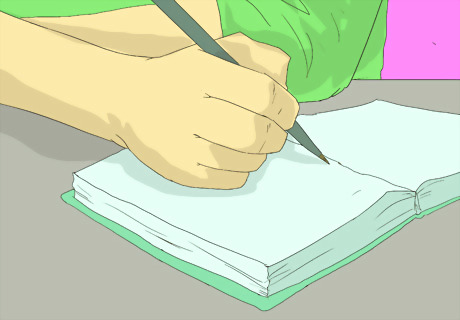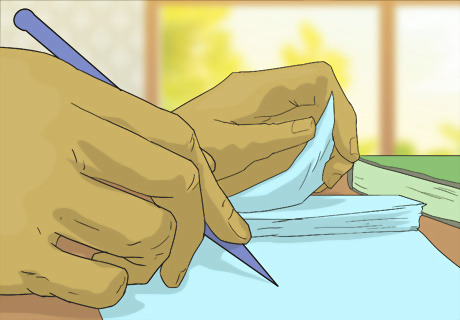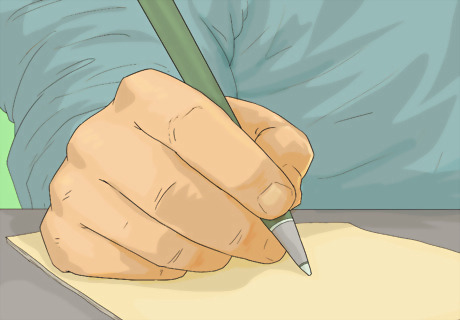
views
Writing Stream of Consciousness

Choose a character or topic. In general, stream-of-consciousness writing is tied to a particular character, as it is intended to illustrate the inner thought patterns of that character. For the character’s thoughts, you could choose a multitude of topics, related or unrelated. This could include people, events, dreams, emotions, activities, items, or anything else. It’s sometimes easier to start with a broader topic if it’s the first time you’ve written stream-of-consciousness. Literally any topic will do, as long as you have something to say about it – even if it doesn't seem like much at first. Using this method, you can connect topics that seem unrelated. For example, you could begin discussing a certain character who loves roses and then immediately switch to a childhood memory of your mother’s rose bushes. This is the way thoughts often work in our heads – so it is also a great way to show how a character thinks and connects ideas in their mind.

Forget conventional grammar. You don’t need to capitalize, punctuate, or even spell correctly. If necessary, make up a word to suit your needs. The point is to get your creative juices flowing, not to focus on line-editing what you write or how you are portraying your character’s thoughts. Remember that the point of this style of writing is to mirror how thoughts naturally flow through our heads, and people don’t typically think in complete sentences with perfect grammar. Ignore sentence structure. You could do an entire page of adjectives, verbs, or nouns related to your topic. Or you could do short phrases, or whatever else comes to mind, as long as it illustrates the character’s thought patterns in a pointed, methodical way.

Revise. Spend some time away from the writing so that you can look over it with fresh eyes. Think about what you wrote and if it seems to be accomplishing the goal you set out to achieve. Go through several drafts if you plan to use your writing for a formal paper or reorganize your ideas so they make cohesive sense. Switch tasks for a little while before coming back to your writing. It doesn’t matter if it’s a few hours or a few days as long as you come back to your writing with a fresh outlook. This type of writing can allow you to provide interesting insights or connections that people normally wouldn’t see. It’s valuable to save this work for future reference to look back over what kinds of connections you made between ideas. Even if it’s weird or bad, make sure you save your writing. You may want to come back to it at a later time or include it elsewhere in your work.

Illustrate inner thoughts and feelings. Stream of consciousness writing is often used to display the interior monologues of characters in stories. This form of writing is meant to replicate the fast-flowing, free-associating way our brains automatically work when we are thinking inside our own heads. So the inner monologue is a stream of often disconnected thoughts, ideas, or subjects. Many famous authors have implemented this strategy in their writing – including James Joyce, William Faulkner, and Virginia Woolf.

Read other examples of this writing style. One of the best ways to master any given style of writing is by reading examples where it is done well. If you find yourself struggling, spend some time reading some texts that focus on the stream-of-consciousness style. You could try reading "Mrs. Dalloway" by Virginia Woolf, Ulysses by James Joyce or As I Lay Dying by William Faulkner.
Using Freewriting as Practice

Familiarize yourself with the form. A great way to prepare yourself for writing in the stream-of-consciousness style is to practice a type of brainstorming called freewriting. This usually involves forcing yourself to sit and write for a predetermined amount of time on a certain topic – though content, grammar, and style should be mostly ignored. The main idea is to keep writing for as long as you can and never take the pen off the paper until the timer dings. This allows you to write more than you think you can and to see how your brain works connecting various thoughts and topics. This makes for great practice for stream-of-consciousness writing because it will give you a model to follow when writing the inner monologues of your characters in the stream-of-consciousness form.

Choose your tools. Freewriting is much better done with pen on paper than on a computer – computers greatly restrict the format of your writing and the flow of your thoughts. Freewriting requires a kind of natural rhythm that is hard to replicate when typing on the computer. Make sure you have extra paper, a pencil sharpener if you’re using a pencil, or an extra pen. If you are on a touchscreen, then try to activate software for drawing writing and test a few actions for comfort and tool sets.

Find a spot to write. If you’re describing something, you should probably have the item in question visible. You should be comfortable – find a spot with the proper lighting, a comfortable seat, and few distractions. The most important thing is to find a place where you can sit comfortably and not be disturbed.

Write. Once you’re ready, just write for a preset amount of time – 5 minutes, 10 minutes, whatever. You don’t have to stick to any particular format. Write backwards, upside down, or in a shape. You could do a spiral starting from the center of the page, or a starburst of phrases, or any other shape that seems to work. Use different colors of pen or pencil. You could change colors every letter, or every word, or in a way that makes the overall work look pleasing. This can be done at any time. Keep writing until you run out of words. But try to push yourself to keep writing until the time is up. Set a timer for the amount of time you want to write and put it somewhere where you can’t see how much time is left. Keep writing without distraction until you hear the timer go off.

Give your brain freedom. It’s not necessary to stay on topic. Freewriting gives you the freedom to write whatever comes to mind, or at least to appear to be doing so. If you start writing about the weather and end up talking about what you had for dinner last night, that’s okay. Freewriting lets you track how your mind roams freely without the constraints of normal writing (thought filtering) processes. Use freewriting as a time to go on tangents and make jumps between topics.

Make connections. By letting your brain wander, you allow it to access information you may have forgotten you knew. Or things you didn't realize you connected to this topic. Your brain houses an enormous amount of knowledge. Letting yourself engage in freewriting is a great way to tap into that internalized knowledge. If you are writing methodically in the freewriting practice, this is also a great way to show how surprising connections can be made between obscure or seemingly unrelated topics. Flowing between ideas allows the connections to be made clearer.

















Comments
0 comment